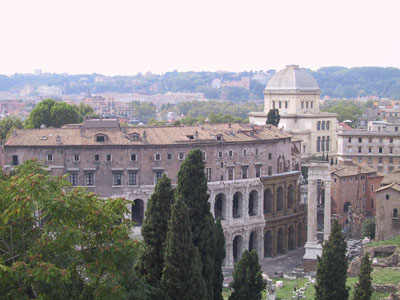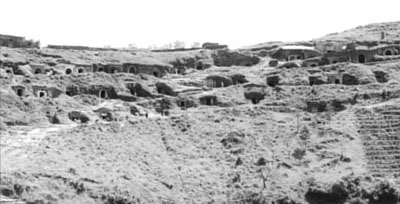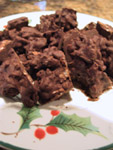Winter dreaming
Holy mackeral it was cold today! Not a day for Christmas shopping up and down State Street. (‘Course, when is?) I’m going to my happy place. Right. Now. Damnit.
Here’s me in 2003 outside Barile, Italy, where Horace composed part of his Odes, excerpted below. In the background is the extinct (yeah, right) volcano Vulture. In the foreground is my belly filled with lovely Aglianico del Vulture wine.

In childhood’s days, on trackless Vultur,
beyond the borders of old nurse Apulia,
when I was tired with play and overcome
with sleep,
the doves of story covered me o’er with
freshly fallen leaves, to be a marvel to all who
dwell in lofty Acherontia‘s nest and Bantia‘s
glades, and the rich fields of Forentum in the dale —
how I slept safe from bears and black
serpents, how I was overspread with sacred
bay and gathered myrtle, with the gods’ help a
fearless child.
Teatro di Marcello

A few years ago the city of Rome opened the renovated Capitoline Museums on its most famous hill. The “Grande Campidoglio” project featured a number of improvements, including the stunning underground Tabularium gallery that lies under the piazza and connects the palazzi via an ancient street. The Tabularium also provides the most stunning views of the Forum obtainable, in my opinion, since you basically can peer out from an opening in the sheer face of the Capitoline Hill over the sunken ruins. In addition, the roof of the Musei dei Conservatori is open as a restaurant and has some great views looking the other way — in this case towards the Janiculum Hill with the Theater of Marcellus, still my favorite example of ancient/medieval layering in the whole city, in the foreground.
Laughs in Rome
Today in Rome I was chatting with the bellhop at the hotel, waiting for a cab. Actually that sounds a lot like we were having a conversation. Edit: I was fracturing his native language as we talked at each other in Italian. Anyway, he asked where I was from. I said Chicago. Oh Chicago, he exclaimed! Then he grabbed himself and said in an absolutely perfect impersonation of half my family “Eh, how you doin’?” Phonetically: ha yo doan? Three syllables, stress on the middle one. I laughed a lot louder than I probably should have, but it was such an odd thing. Here was an Italian impersonating what I have always regarded as an Italian-inflected mangling of English like you hear in many urban areas. I didn’t have the vocabulary to note the irony to him.
My second laugh was today at a coffee shop watching an American try to order a cafe mocha like she clearly does at Starbucks back home. The barista was utterly befuddled. And here she thought she was so cultured. They both left that transaction disappointed I think.
The pope thought my Italian sucked

I studied in Rome in 1993. My roommate was a seminarian who made it his job to get to know people at the Vatican. He ended up arranging a papal audience for us — nothing private, just part of the larger scheduled audiences — and he was able to situate himself (and me) right on the aisle down which the pope would stroll. Sure enough, il papa came right over to me and asked me where I was from. I responded in Italian (since he asked in Italian) that I was from Chicago. Smirking, he responded in English — presumably because my Italian was so atrocious — that he had visited Chicago many times. Then the stream of outstretched hands pulled him further along the aisle and my encounter with Pope John Paul II was over.
When I heard that the pope had died on Saturday I was preparing to attend the wedding of a friend. The radio broadcast I was listening to mentioned that a special service in Chicago would be held by Cardinal George at Holy Name Cathedral, the main Catholic church in the city, at 5:15pm. The wedding I was going to was scheduled for 4pm at that same church.
What a spectacle. Even as the wedding started a steady flow of mourners was filtering into the church, somewhat befuddled that a celebration was taking place therein. Once they figured out that the wedding would end soon enough they seemed not to notice it at all, filling in every open seat all the way to the front of the church. Meanwhile row after row of news cameras were sprouting up along the aisles. Seemingly entire orders of nuns marched solemnly in and took up seats very close to the bride’s and groom’s parents. A lone bridal party usher — normally a role whose most difficult task is figuring out which side of the church arriving guests should sit on — literally had to body-block churchgoers from entering the church down the center aisle. It was all somewhat surreal.
By the time the newlyweds turned around to face their family and friends, the vast cathedral was packed to overflow capacity — something I’d wager only the most regal weddings even come close to achieving in that space. The bride was completely dumbstruck at the sight. (And I bet the groom was thinking “I hope they don’t think they’re all coming to the reception.”) I have to admit that the bishop presiding over the wedding did a good job steering clear of what could have been a maudlin matrimonial ceremony, choosing rather to focus on the bride and groom almost exclusively. But the swell of silent, mourning Catholics into a space of such joy created one of the most unintentionally bizarre atmospheres I think I have ever witnessed. I’m having trouble dreaming up anything more ridiculous than the sight of weeping nuns pushed aside by a reporter from People Magazine (yes, People — huh?) trying to intercept the departing bride for an interview.
Barile
My great-grandparents came to America in 1903 from a small town called Barile in the region of Basilicata, Italy — basically the “instep” of the boot. I’ve visited Basilicata twice — more on that in an upcoming series of posts — and, though it has made much progress in the last ten years, I often find myself calling it the West Virginia of Italy. Rustic and mostly arid, many of the towns in the region are built on top of or straight out from sassi, the caves carved into soft rock that have formed the homes of inhabitants since well before Roman settlement of the peninsula.
Mel Gibson’s The Passion of the Christ was shot mainly in Matera, Basilicata, the town with the most striking sassi in the region. Shortly after seeing The Passion I learned that Gibson was merely following the Italian filmmaker Pier Paolo Pasolini in shooting a life of Christ in the region. In 1964, Pasolini released Il Vangelo secondo Matteo, a cinema vérité treatment of the gospel of Matthew using non-actors from Basilicata. I’ve read that Italian audiences actually demanded subtitles because the Albanian dialect of the “actors” was too difficult to understand. There’s absolutely no dramatic flourish in the film (a path Gibson diverged from in minute one of his film). This is Christ-as-peasant-among-peasants, seen from ground level. Call it Reality Hagiography.

The sassi of Barile form the backdrop of the “slaughter of the innocents” scene. It is hard not to laugh at the centurions as they scamper up and down the hillside slashing at mothers and babies (some of whom fly out of embraces a little too easily). The film is likely to irritate modern viewing sensibilities for one reason or another, especially since the English dubbing is just awful. But I applaud the effort in the context of when and where it was made. If you’re going to shoot Christ as a man of humble origin you’ll not err in choosing Barile as a home town.
Compare the shot from the film above to a panorama of the same caves, now private wine cellars, taken last year.
Carbone Dolce

Here’s an easy way to remind the kids that they’ve been bad this year without scarring them for life. There’s a super-simple, traditional Italian dessert called Carbone Dolce, literally “sweet coal”, presumably a confectionary joke, but possibly pre-dating the whole stockings for bad kids thing. In any event, it could not be easier. You melt 400 grams of chocolate then mix in about half that in crushed Rice Crispies, form into coal-like clumps, and let cool. Voila! All the recipes I’ve come across are in Italian and I know they call for white chocolate, but I cannot figure out how or why you’d make something look like coal with white chocolate. Any ideas? Anyway, add a few pretzel sticks to the mix and you’ve got yer sticks and coal for the holidays. Better than pre-packaged, I’ll say.
Merry Christmas, dear readers!
Here’s the crew of Apollo 8 sending a Christmas Eve wish (Quicktime) to Earth as they orbited the moon, the first humans to do so, 36 years ago.













